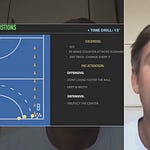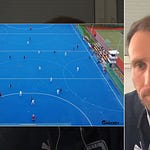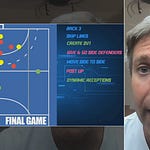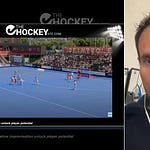We just wrapped up another thought-provoking masterclass in our ongoing series at thehockeysite.com, and this time we had the distinct pleasure of hosting Tin Matkovic. If you haven’t crossed paths with Tin yet, he’s a Croatian coach who’s been deep in the trenches of the German Bundesliga, most recently coaching in Berlin. His topic for this session—“Eyes Up,” a deep dive into the art and science of pre-scanning—felt tailor-made for coaches who understand there’s more to “head up hockey” than a half-hearted glance over the shoulder.
Meet Tin Matkovic: Mapping the Field, One Scan at a Time
Tin brings that rare blend of hands-on experience and open-minded curiosity, and his approach to coaching pre-scanning (or game awareness, as some of us may call it) caused us to question our habits and assumptions. Not only did he confirm a lot of what we try to ingrain on the training pitch, he pushed us to reframe why and how we teach the art of looking up.
Key Takeaways from the Masterclass
Here’s a crisp summary of the main topics Tin walked us through—think of this as your cheat sheet before you dig into the on-demand recording:
1. Scanning is Mapping, Not Just Looking Tin kicked things off with a creative analogy from the movie Prometheus: scanning is like sending a probe into uncharted territory, mapping your environment every time you turn your head. Each scan is a piece of the tactical puzzle. Every time a player turns, they “unlock” new spatial information and options.
2. Mapping Routes Out—Pre-Scan for Playmaking and Safety At its core, scanning is about mapping escape routes, safe exits, and creative connections. Tin emphasized mapping not just for safety, but for manipulating space, finding open channels, collapsing or stretching the zone, and being proactive rather than reactive as situations evolve.
3. Creativity and Understanding—Beyond “Because Coach Said So” Tin made it clear: don’t let pre-scanning become a robotic instruction. Players should understand why they're looking—maybe they want to manipulate a defender, fake one way and break the other, or cue a teammate to create a 2v1 somewhere else. The “why” makes the “how” meaningful.
4. Position-Specific Scanning: 180° or 360°? Not all scanning is created equal. Outfielders on the flanks may only need to scan 180°, while central midfielders must have that coveted 360° awareness. Tin detailed how scanning patterns, angles, and frequency change by position—midfielders, in his words, are the “engine of the team,” needing the tightest mapping and fastest adjustment.
5. Timing and Visualization—It’s About “When” as Much as “What” Scanning isn’t about random glancing. Tin explained that a scan done too early or late is wasted—or worse, actually harmful, especially as ball receiving in hockey is so nuanced compared to football. Scanning must be timed with the likely arrival of the ball, coordinated with body position, and followed by mental visualization of the next touch or pass.
6. Scanning to Solve or Create Problems: Defensive and Offensive Pre-Scanning There’s offensive scanning (how do you expose/manipulate space as a ball-carrier or receiver?) and defensive scanning (noticing pressure, organizing cover, or even—yes—a one-time Olympic final sideline sneak). Tin reminded us not to sleep on the value of defensive off-ball scanning. Sometimes your backfield general is the hidden MVP in team awareness.
7. Off-Ball Awareness and Team Buy-In Even when players don’t expect the ball, Tin urges us to cultivate constant scanning: is the opposition rolling into a zonal overload, collapsing a box press, or prepping an overhead? Encourage your non-possessors to map, visualize, and communicate.
8. Drills for Juniors and Beyond: Make the Why Explicit For juniors, Tin likes to create modified visual and communication-based drills—sometimes using cones, colors, fingers, or simply positioning. But always, always, he hammers home the logic of the scan: “If you know where you’re going before you get the ball, decision-making gets easier.”
9. Measuring Scanning—What (and How Much) Do We Track? From manual “click counters” to detailed coding in video analysis, Tin discussed the merits and limitations of measuring scanning events per player—and, crucially, using video to teach not just the frequency, but the quality of scanning.
10. “There is No Wrong in Hockey—Only Your Vision and Your Why” Maybe our favorite Tin-ism of the day. Every coach has their own flavor; the real magic comes in knowing your team’s capacity, explaining the purpose behind every concept, and evolving your training approach as your athletes progress.
“Scanning is actually mapping and puzzling. Every time you turn around, there’s a new map unlocked, a part of the field unlocked. That’s what makes hockey dynamic—and what makes pre-scanning essential.”
In Summary
If you thought pre-scanning meant just “look before you receive,” Tin just turned that idea upside-down and inside-out. Game awareness, mapping, defending off the ball, measuring scanning intelligently, and building it into your team’s DNA—it’s all there.
Your next step? Watch (or re-watch) Tin’s masterclass to catch all the nuances, arguments, and live Q&A banter with an engaged crowd of curious coaches.
Or, if you’re a paid subscriber, first continue to read this deep dive into his insights below…
Listen to this episode with a 7-day free trial
Subscribe to The Hockey Site to listen to this post and get 7 days of free access to the full post archives.













